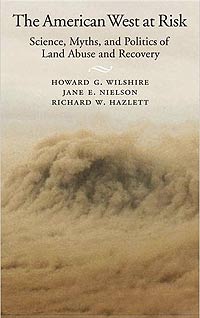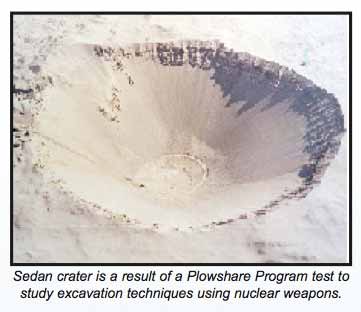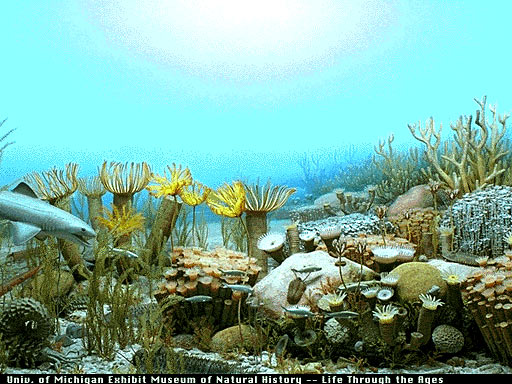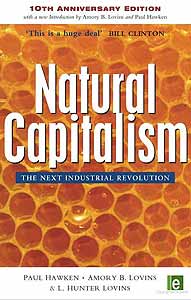Biblio
Using the latest in satellite imagery, aerial photography, and Google Earth technology, this ten minute SkyTruth video explores the environmental impacts of gas and oil drilling in the Upper Green River Valley, an ecologically sensitve area of western Wyoming.
See the view of the Upper Green Valley in Wyoming from the air and the effect of hundreds of gas drilling well pads. According to SkyTruth, 10,000 well pads have been proposed.
U.S. Senate. Committee on Environment and Public Works. Health Risks to Children and Communities From Recent EPA Proposals and Decisions on Air and Water Quality.
Submitted in Writing to Hearings before the Committee on Environment and Public Works,on February 6, 2007. Statement of Gina M. Solomon, M.D., M.P.H., Senior Scientist Natural Resources Defense Council, Associate Clinical Professor of Medicine University of California, San Francisco. 19 pages.
"Unfortunately, EPA is taking several major steps to eliminate information and decrease health protection from environmental hazards. Six recent draft or final EPA rules will each significantly limit critical information available to scientists, health care providers, communities, and ironically to EPA itself. As a result, children and communities will be left less protected and less able to protect themselves."
"The American West at Risk emphasizes the need for genuine concern for our precious soils, freshwater, and other environmental resources. As the authors document, we should be making every effort to conserve and protect all our vital natural resources, which indeed support human life."--David Pimentel, Cornell University
"If you wish to be informed, enraged, enlightened, and appalled about the American west, this is the book to read."--Journal of Environmental Quality
See: Gasbuggy Nuclear Test Site.
The Gasbuggy Nuclear Test Site is the location of a 1967 underground nuclear explosion, conducted to test the viability of using a nuclear device to aid in natural gas extraction. It was part of the Plowshare Program, the program to develop peaceful uses of nuclear weapons, and was the first use of a nuclear explosion for industrial purposes.
See: Google-eye view of a nuclear test site - Boing Boing
See: Appendix 7, p. 399.
Plowshare can help mankind reshape the earth into a Garden of Eden by overcoming the forces of nature.
-Glenn Seaborg, Man and Atom (1971)
Description
The American West at Risk summarizes the dominant human-generated environmental challenges in the 11 contiguous arid western United States - America's legendary, even mythical, frontier. When discovered by European explorers and later settlers, the west boasted rich soils, bountiful fisheries, immense, dense forests, sparkling streams, untapped ore deposits, and oil bonanzas. It now faces depletion of many of these resources, and potentially serious threats to its few "renewable" resources.
See: Fracking for Natural Gas | The American West at Risk Blog.
See: Environment: Project Dubious (1973). Time.
See: Adam Lederer. Project Wagon Wheel.
Brown, C. F. “A history of the development of the Pictured Cliffs Sandstone in the San Juan basin of northwestern New Mexico.” Cretaceous and Tertiary rocks of the southern Colorado Plateau: Four Corners Geological Society Memoir (1973): 178–184.
Schneider, Keith. New York Times. Aug. 26, 1990. "In the Trail of the Nuclear Arms Industry."
"In the Trail of the Nuclear Arms Industry; What's Left Behind." Listing of sites. Contaminated processing plants, laboratories, nuclear reactors and testing grounds that were part of the nuclear weapons industry.
Jones, S. “Elimination Report: Project Rio Blanco.” U.S. Department of Energy | Office of Legacy Management, October 15, 1985.
Heiss, K. P. U.S. Atomic Energy Commission. Speical Report. Aug. 31, 1967. “The Economic Potentials of Natural Gas Production Stimulation by Nuclear Explosions.” Princeton: Mathematica Inc. (1967). (PDF, 8MB).
Chedd, Graham. “Plowshare's death rattle at Rio Blanco.” New Scientist 8, no. 1973. New Scientist (March 8, 1973): 544-545.
Download: Bombs for Peace Moratorium Ends- Testing Begins (2.5 MB)
The American West at Risk chronicles the road our nation has taken to its current catastrophic environmental state. The authors tour the U.S. to discuss challenges our nation faces & examine viable solutions.
Digital landscape of the pristine Upper Delaware Watershed - before and after gas drilling.
A slow quiet simulated time lapse on what can happen to the scenic Delaware watershed as gas drilling proceeds in Pennsylvania.
Bruce Baizel. Testimony presented to the Committee on Environmental Protection, James F. Gennaro, Chair, Council of the City of New York, September 10, 2008. Earthworks Publications. Durango, CO.
"My testimony will first address the three main risks to water posed by gas development: well drilling and production, hydraulic fracturing and transportation of fluids to and from the wellsite. I will then briefly describe some specific incidents that illustrate these risks in a number of different states. Then, I will briefly discuss the current New York regulations most applicable to the risks associated with gas development. Finally, I will present some of the approaches that other municipalities and states have developed to try to address these risks."
Bruce Baizel is Senior Staff Attorney for the The Oil and Gas Accountability Project, a program of Earthworks, P.O. Box 1102, Durango, Colorado 81302.
See: Lustgarten (2009) "Buried Secrets: Gas Drilling’s Environmental Threat - ProPublica"
This video shows a Grandfather changing the water filter on his well water in Prenter, WV. Coal Waste has been injected into abandoned underground mines near his house. See sludgesafety.org for more info on coal slurry.
Hydrofracking involves storing gas underground and disposing of fracking sludge in abandoned mines, both a potential threat to groundwater.
See Aurora Lights article on Coal Mining's effect on clean water in West Virginia.
Climate change issues bring into greater prominence that all the world's people are linked together and that we all have a stake in creating a sustainable path for the planet and no such path can allow for 10 million avoidable child deaths each year.
--Kirk Smith, UC Berkeley, School of Public Health
Whatever your goal (economic growth, stable population democratic institutions, global equity, art, literature, science, an educated electorate, etc.), it is impaired by excess child mortality.
Malnutrition is the single most important risk factor for child mortality. According to Kirk Smith, "each of [its'] separate causes is thought to be increased by both climate change itself and, potentially, by efforts to combat climate change through biofuel expansion [and] energy price rises."
Professor Smith’s research addresses the relationships among environmental quality, health, resource use, development, and policy in developing countries, and the implications for policy of the potential to achieve co-benefits (health and climate) from pollution control in developing countries.
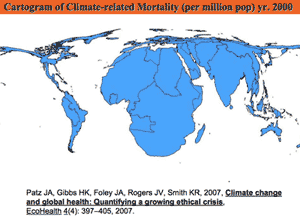
"One of the few positive sides of the climate change crisis is that the global village is no longer just an intellectual construct.
That we have one planet, one atmosphere, one set of mutual responsibilities, and one fate – these are now clear."

Thank you Professor Smith. I ask, what is the value of a human life? Climate change is going to kill millions of children, does it matter that they're not yours?
The value of a life in the United States is a factor in the quality of regulation and enforcement of the Clean Air Act, the Clean Water Act, and climate change policy initiatives that may not survive the Climate Zombies of the U.S. Congress.
As Washington and our insurance companies estimate an individual life's value at around 4 to 6 million dollars, the warrant for increased regulation of toxic industry seems more justified. Yet, the oil and gas industry and their government advocates still question the legal authority of the EPA and U.S. congress to enact and enforce environmental regulations as they relate to both climate change and the enormous consumption of water associated with hydraulic fracturing.
There are sociological and economic impacts of an unregulated energy industry. A tightly connected global ecosystem depends more and more on both a food and water supply that has become more privatized, making it difficult for self-sustaining indigenous farming to succeed.
One week's worth of food by various cultures:
Hundreds of millions of children are slated to die already, mostly by starvation, because of our present inaction.
The oil and gas industry has shown no evidence that it is ready or capable of self-regulation. It becomes an increasing threat to the health of humanity. (Neil Zusman. 2011-02-24)
"The exploitation of fossil fuels is integral to modern living and has been a key element of the rapid technological, social, and cultural changes of the past 250 years. Although such changes have brought undeniable benefits, this exploitation has contributed to a burden of illness through pollution of local and regional environments, and is the dominant cause of climate change.
This pattern of development is therefore unsustainable at a global level. At the same time, about 2·4 billion of the world’s population, disadvantaged by lack of access to clean energy, are exposed to high levels of indoor air pollutants from the inefficient burning of biomass fuels." (Wilkinson, 2007).
Smith, K. R, and E. Haigler. “Co-benefits of climate mitigation and health protection in energy systems: scoping methods.” Public Health 29 (2008): n. pag. Print.
Smith K.R., "Mitigating, Adapting, and Suffering: How Much of Each?", (Symposium on Climate and Health, KR Smith, ed), Annual Review of Public Health 29 (2008): 23. Print.
Wilkinson, Paul. et al. “A global perspective on energy: health effects and injustices.” The Lancet 370.9591 (2007): 965-978. Web.
See: Appelbaum, Binyamin. “A Life’s Value May Depend on the Agency, but It’s Rising.” The New York Times 16 Feb. 2011. Web. 17 Feb. 2011.
See also: Associated Press. "How to value life? EPA devalues its estimate: $900,000 taken off in what critics say is way to weaken pollution rules." 2008-07-10.
From Publishers Weekly
Through vivid first-person reporting and a thorough culling of court transcripts, newspaper clippings and corporate reports, Vanity Fair contributing editor Shnayerson (The Killers Within) has crafted an incriminating indictment of the Appalachian King Coal industry in West Virginia, and of the man he defines as its rapacious kingpin, Massey Energy's CEO, Don Blankenship.
The author's sympathies lie clearly with opponents of mountaintop mining, most prominently young attorney Joe Lovett and citizen activist Judy Bonds. Both have fought against a form of mining that shears off the tops of hills and dumps rubble into valleys and streams—a process abetted by the collusion of the state's often-lackadaisical Department of Environmental Protection, the U.S. Army Corps of Engineers' propensity to grant stream-destroying permits without oversight and the easing of environmental controls by the Bush administration.
Shnayerson's compelling take on toxic mining methods and their heartrending impact on Appalachian inhabitants and their culture, has a wider focus than Erik Reece's 2006 title, Lost Mountain, which reported on one mountaintop's destruction, and strong echoes of the stomach-churning legal machinations recounted in Jonathan Harr's 1995 bestseller, A Civil Action.
See: Michael Shnayerson web page.
See: Marsh Fork Elementary: Journey Up Coal River | A Community and Strip Mining
See: WATER | Aurora Lights. Public Health & Coal Slurry - Water Quality ::: Journey Up Coal River
See: Tree spiker : from Earth First! to lowbagging: my struggles in radical environmental action
See: Leveling Appalachia: The Legacy of Mountaintop Removal Mining
See: Environmental Issues and Challenges in Coal Bed Methane Production
See: Climate Ground Zero
See: Mountaintop Removal
If You Give Up, They Give Up - Stop Global Warming.
A dark, moody animation that children may not like to watch. A monkey, polar bear and kangaroo kill themselves because their world is ruined. TV Spot created by McCann Erickson Portugal for Quercus - National Association for Nature Conservation.
Produced by Seagulls Fly São Paulo.
See: The Tragedy of the Commons
See: Global Warming
See: Global Warming Frequently Asked Questions
See: Polar Bears (video)
See: Train (video)
See: Futurism Now (blog)

Irena Salina's award-winning documentary investigation into what experts label the most important political and environmental issue of the 21st Century - The World Water Crisis.
Salina builds a case against the growing privatization of the world's dwindling fresh water supply with an unflinching focus on politics, pollution, human rights, and the emergence of a domineering world water cartel.
Interviews with scientists and activists intelligently reveal the rapidly building crisis, at both the global and human scale, and the film introduces many of the governmental and corporate culprits behind the water grab, while begging the question "Can anyone really own water?"
Beyond identifying the problem, Flow also gives viewers a look at the people and institutions providing practical solutions to the water crisis and those developing new technologies, which are fast becoming blueprints for a successful global and economic turnaround.
See: Jeannette Catsoulis. Sept. 12, 2008. The New York Times. "The War Between Public Health and Private Interests".
See: Cory Doctorow . Apr 7, 2008. BoingBoing.net. "For Love of Water: infuriating and incredible documentary about world's water-crisis".
See: World-Renowned Scientist Dr. Theo Colborn on the Health Effects of Water Contamination from Fracking
See: Clean Water Action
See: WATER: Rulings Restrict Clean Water Act, Foiling E.P.A.
and Supreme Court Restricts Clean Water Act
See: WATER | That Tap Water Is Legal but May Be Unhealthy
See: WATER | FRONTLINE: Poisoned Waters
See: Drinking Water: Understanding the Science and Policy behind a Critical Resource
See: Connie Watson, CBC Radio | Feb. 4, 2003. "Sell the rain: How the privatization of water caused riots in Cochabamba, Bolivia".
See: SERC (State Environmental Resource Center). 2004. "The Meaning of Privatization."
Implications of Privatization of Water Utilities
[Provides] examples where privatized water utilities have posed risks of rate hikes, negative economic impacts, inadequate customer service, and harm to natural resources...
Announcer: Paul Bison agreed back in March to let Chesapeake drill a well on his 80 acres in Keithville.
Paul Bison: Nobody in the section, in the neighborhood is gonna ever benefit unless somebody lets 'em drill and when we leased three years ago, we knew what it was for, we took the money and now it's time for somebody to step up to the plate and help em let it happen.
Nolan Hart. (2008). Includes photos, maps, illustrations.
Named for the town of Marcellus New York, where the shale reaches the surface, it is a Devonian age (roughly 390 million years old) member of a geological structure known as the Hamilton group. It formed when Devonian age seas...covered much of North America.
Kurt Repanshek. November 5, 2008. National Parks Traveller.
These and other slices of the public lands landscape deserve some form of protection for visitors today and tomorrow to enjoy. And yet, the outgoing Bush administration is determined to open them to drilling rigs with all their associated access roads, noise, air, and, potentially, water pollution.
How much is too much? When the oil and gas industry in Utah has nearly 3,500 drilling permits in hand, but which have not been acted upon, why is the Bush administration selling them more, particularly in sensitive areas around national parks and monuments?
Conservation groups such as the National Parks Conservation Association, The Wilderness Society, and the Southern Utah Wilderness Alliance warned that the BLM was poised to announce on Election Day that it was ready to sell hundreds of oil and gas drilling leases in the above-cited places as well on lands surrounding Dinosaur National Monument, Arches National Park, and Canyonlands National Park.
But when Election Day arrived, BLM officials merely announced they were opening 360,000 acres to oil and gas work without specifying exactly where those leases would fall.
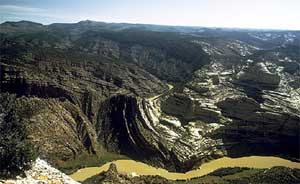
See: Environment News Service (ENS). Bush-Era Oil and Gas Leases Near Utah Parks Canceled. 2/4/2009.
See: Deseret News. Geoff Liesik and Mary Bernard. "Judge says drilling lease lawsuit too late". Salt Lake City. 9/2/2010.
See:Earthworks: 4/1/2010 "Obama's gifts to extractive industries continue with defense of Bush mining policy".
See: Student Disrupts Government Auction of 150,000 Acres Of Wilderness For Oil & Gas Drilling.
Hawken (The Ecology of Commerce) and Amory and Hunter Lovins of the Rocky Mountain Institute, an environmental think tank, have put together an ambitious, visionary monster of a book advocating "natural capitalism."
The short answer to the logical question (What is natural capitalism?) is that it is a way of thinking that seeks to apply market principles to all sources of material value, most importantly natural resources. The authors have two related goals: first, to show the vast array of ecologically smart options available to businesses; second, to argue that it is possible for society and industry to adopt them.
--Publishers Weekly
See: Paul Hawken. "Natural Capitalism | We can create new jobs, restore our environment, and promote social stability. The solutions are creative, practical, and profitable." Mother Jones. Mar/Apr97.








